
Rehab Banu Hasan is a biblical city mentioned in the Second Book of Samuel (10:6), in which it is narrated that the king of Ammon sent with a request twenty thousand men from the Syrian Rehab and from Soba to fight, and recruited them in his army against King David, whose army came from Jerusalem under the command of Joab in order to Defeat the armies of Ammon. This city is also mentioned in the Book of Judges (18:28). This includes the most important monuments in the area of Christianity, eight churches built in successive periods.

The town of Rehab Bani Hassan is located on the road between Mafraq and Jerash, about 26 kilometers away from Jerash. It reached its golden age in the sixth and seventh centuries AD, when it was a stop on the caravan route between Bosra al-Sham and Jerash.
The history of Rehab is very ancient, as its name was mentioned in the lists of the names of the cities occupied by the Pharaoh of Egypt, Thutmose III (1490-1436 BC), but it rebelled and left Egypt during the reign of Amenhotep IV (Akhenaten 1371-1358 BC). Rehab remained free until the first year of the reign of Pharaoh Seti I (1317-1301 BC) of the nineteenth dynasty.
Rahab Bani Hasan is also a Biblical city, as mentioned in the second book of Samuel (10:6), in which it is narrated that the king of Ammonites sent and hired twenty thousand men from the neighboring Aramaic kingdom of Beth Rehob, and from the Aramaic of Soba, to support his army and face an army David, who came from Jerusalem led by Joab to seize Ammon (Amman). In the battle outside the city walls, the Arameans were defeated, while Joab's army, but Joab was unable to conquer the city and control it, so he returned to Jerusalem.
Many Bible scholars believe that Rehab mentioned in the Book of Numbers (13:21) is Rahab Bani Hasan. When the prophet Moses sent men to survey the land of Canaan, they went up and surveyed the land from the wilderness of Zin to Rehob (Rehab) at the entrance to Hamath. Archaeologists also suggest that Rehab, which was mentioned in the Book of Judges (18:28), is Rahab Bani Hasan. The travel of the judges narrated the migration of the children of Dan and their capture of Lapish, and the people of Lapish were a calm and safe people. And the children of Dan struck him with the edge of the sword, and burned the city with fire, and the city was in the valley that was at Beth Rehob.
When the era of church persecution ended at the beginning of the fourth century AD, Bosra al-Sham was the center of the “Arabia Petraea- Arabian Province” and a number of Jordanian cities and villages were affiliated with its diocese, such as Rehab Bani Hassan, Khirbet al-Samra, Umm el-Jimal, Sama al-Sarhan, Sabha, Subhiya, Umm al-Qatin, and Deir al-Kahf, Qasr Al-Hallabat, etc., and Bosra was also a reference for a number of Jordanian dioceses such as: Jerash, Amman, Hasban and Madaba.
As for the most important traces of Christianity, they are the effects of eight churches, including two churches built during the reign of Peodorus, Archbishop of Basra, namely: the Church of the Prophet Isaiah, and the Church of Saint Mina in the year 634, that is, on the eve of the Arab conquests. A third church was built during the reign of Agapius, the Archbishop, which is the Church of St. Mary, which was built in the year 534, at the entrance to the town, on the side of Jerash. Its walls are still slightly higher than the surface of the earth. One of her writings mentions that it was restored in 582, that is, fifty years after its construction.
Five other churches were built during the reign of Poliocus, Archbishop of Basra, which are: the Church of St. Basil in the year 594, the Church of St. Paul in the year 596 with its three naves and mosaics with beautiful geometric shapes, the Church of St. Sophia in the year 604, the Church of St. Stephen in the year 620, and the Church of St. Peter which It was built during the Persian rule of the country in the year 624, which indicates that the inhabitants of the province had returned, during the Persian rule, to their usual way of life.
The large number of churches indicates the era of flourishing Christian life in them.